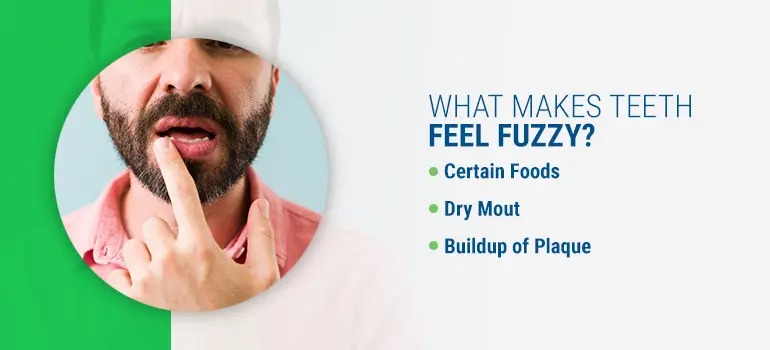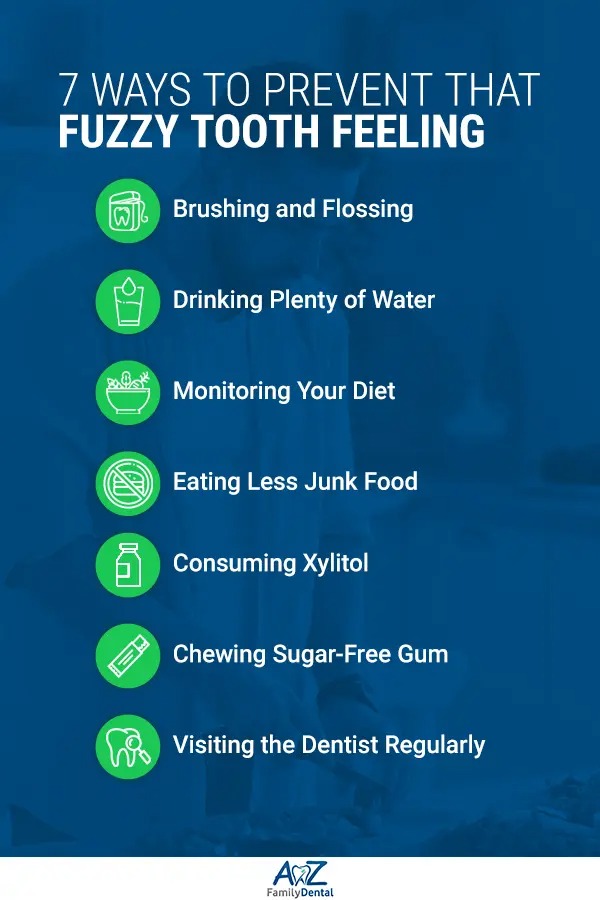
When you run your tongue across your front teeth, how do they feel? Are they nice and smooth, or do you notice a fuzzy or coated texture?
It’s common for teeth to develop a film for several reasons. Although glossy teeth are a sign of great oral hygiene, a textured mouth can be just as healthy with a bit of extra attention.
This guide can help you get to the root of the problem so you can take the proper steps for a polished smile.

Are Fuzzy Feeling Teeth Bad?
Sometimes, having a fuzzy coating around your teeth can be a sign of damaging dental conditions. Other times, it has no impact on your oral hygiene.
Identifying the reason why your mouth feels furry will help you determine the status of your dental health. Regardless, squeaky clean teeth can look and feel better.
There is no need to feel ashamed of your fuzzy teeth. There are simple ways to cure that coated sensation once you discover why it’s happening.

What Makes Teeth Feel Fuzzy?
Often in the morning or after a meal, teeth can develop a rough coating. What makes teeth feel coated depends on your eating habits and hygiene. Finding the root cause will help you discover the proper treatment to eliminate that fuzzy feeling. Here are the three most common causes of textured teeth:
1. Certain Foods
If you were to guess, you might assume that junk food and candy cause coated teeth. While they can cause dental challenges, salty snacks and sugary drinks are not the only culprits. Surprisingly, leafy greens and other healthy vegetables are to blame.
While most vegetables are great for your oral health and the rest of your body, some contain oxalic acid that mixes with saliva and creates a strange sensation in your mouth. While oxalic acid is safe for the body and teeth, it can create that fuzzy tooth feeling.
The following foods are rich in oxalic acid:
- Tea
- Rhubarb
- Spinach
- Beets
- Kale
- Swiss chard
- Turnip greens
- Sweet potatoes
The calcium deposits in your saliva mix with the oxalic acid in these foods, creating calcium oxalate crystals that bind to your teeth. These tiny particles will coat your mouth in a layer of gritty crystals. While this mixture is harmless to the enamel — the outer layer of the tooth — it can make your teeth feel grimy when you eat certain foods.
2. Dry Mouth
If your teeth feel sticky or coated, a dry mouth may be the cause. Your mouth needs a consistent supply of saliva to stay hydrated. A dry mouth can lead to some uncomfortable symptoms and could be the reason why your mouth feels fuzzy inside.
Dry mouth is extremely common and can be caused by many different conditions such as:
- Sleeping with your mouth open: This is one of the most common causes of dry mouth. Surveys show that 71% of beds across America contain at least one mouth breather. Breathing through your mouth at night dries out your tongue, gums, and teeth, leaving behind a dried coating of saliva.
- The medications you take: A wide range of medications can cause dry mouth symptoms. Without enough saliva to wash food and bacteria off your teeth, plaque can build up and make your teeth feel fuzzy.
- Blockages in your nose: If you’re prone to allergies or congestion, you may experience frequent blockages in your nose. When your nose is stuffed with mucus, you are forced to breathe through your mouth. Mouth breathing can cause dry mouth and that coated tooth feeling.
- Symptoms of diabetes: Diabetes itself and the medications to treat the disease can cause dry mouth. If left untreated, dry mouth can harm your teeth and make your mouth feel unpleasant.
- Drinking too little water: Depending on your size and lifestyle, you should drink 11.5-15.5 cups of water every day. Your body needs water to function properly, and your mouth is no exception. Saliva is almost entirely made of water and is essential for keeping your mouth moist. If you drink too little water, you are likely to develop a dry mouth, making your teeth feel strange.
Identifying the source of your dry mouth will help you manage your symptoms so you can experience smooth and hydrated teeth.
3. Buildup of Plaque
Another common cause of fuzzy teeth could be a buildup of tartar and plaque. Improper cleaning, eating too many sweets, or drinking too much soda can contribute to a thick layer of plaque on your teeth.
Plaque is bacteria that sticks to your teeth and can create a film around your mouth. It’s normal to have a small amount of plaque on your teeth throughout the day, which is why it’s so important to brush your teeth regularly. If left unchecked, plaque will multiply and grow thicker on the surface of your teeth. This can contribute to that fuzzy tooth feeling and damage your teeth over time.
Plaque feeds off food particles in your mouth and releases acid that can wear away at your enamel. It can also cause cavities, tooth decay, and gum disease. In extreme cases, the bacteria can become so concentrated that it enters the bloodstream, potentially leading to cardiovascular diseases.
If you’re unsure if plaque is causing your teeth to feel fuzzy, you can look for these signs:
- Bad breath: Stinky breath in the morning or after eating smelly foods is normal. However, if you notice that you have bad breath most of the time, it could be caused by too much plaque. Plaque is made of odor-causing bacteria that can give your breath an unpleasant scent.
- Sensitive gums: Sore gums that bleed when you brush your teeth are signs of too much plaque. An abundance of plaque can lead to gum disease like gingivitis.
- Frequent cavities: Plaque damages the enamel on your teeth, leaving them vulnerable to developing cavities. If you’ve gotten a lot of cavities lately, your teeth probably have too much plaque.
- Discolored buildup: If you notice a yellowish buildup near the base of your teeth, it may be plaque or tartar deposits.
Brushing and flossing can diminish normal amounts of plaque, but an excess amount can transform into tartar that only dentists can remove. Hardened tartar deposits can form across your teeth, creating a rough texture.

7 Ways to Prevent That Fuzzy Tooth Feeling
Depending on why your teeth feel fuzzy, one or more of these methods can help make your teeth feel silky smooth.
1. Brushing and Flossing
If your teeth are feeling coated with a sticky film, brushing and flossing is your first line of defense. It can help relieve your symptoms no matter what is causing your teeth to feel strange.
Proper oral hygiene will prevent plaque from building up and flush out any oxalate crystals stuck to your teeth.
Effective dental care starts with the proper tools. A good toothbrush, dental floss, and mouthwash will help you scrub away that fuzzy film to reveal a glossy smile.
Dentists recommend that you brush twice and floss once per day. Rinsing your mouth out after a meal can help remove food debris, but brushing too much can actually damage your enamel. Brushing once in the morning and once before bed provides the perfect balance.
Flossing every day is essential for reaching plaque and food debris that gets wedged in between teeth. Finishing off your oral cleaning routine with a quick rinse of mouthwash will help to clear out any remaining bacteria. Most mouthwash products recommend rinsing after brushing — twice per day. Some varieties even hydrate the gums to help soothe dry mouth symptoms.
2. Drinking Plenty of Water
Drinking water is great for your body and is especially helpful for your dental health. It hydrates your mouth and promotes saliva to prevent dry mouth and tooth decay. It can also wash away leftover food that gets stuck in your teeth after meals. This reduces the food supply for bacteria-rich plaque. Drinking fluoride-infused water is especially great for strengthening teeth and eliminating that fuzzy tooth feeling.
3. Monitoring Your Diet
The solution to smooth teeth does not require cutting oxalic-rich foods from your meal plan. Vegetables like spinach, kale, and beets are part of a balanced diet, and some are beneficial to protecting your enamel. You can and should still enjoy these vitamin-rich plants while you treat your textured teeth.
One way to prevent fuzzy teeth when eating oxalic foods is to cook your food. Steaming, boiling, baking, or cooking oxalic-rich foods can help lower the acid content.
You should also watch your vitamin C intake, as too much can boost oxalic production. Fruits and vegetables that contain vitamin C include:
- Red peppers
- Kiwi
- Green peppers
- Broccoli
- Brussels sprouts
- Grapefruit
- Oranges
- Strawberries
- Cantaloupe
It’s best to consume citrus fruits like orange and grapefruit in moderation because citric acid can damage your enamel. Visiting the dentist’s office regularly can also help you maintain your enamel. Experienced dentists can evaluate your teeth for damage from citric acid and suggest other ways to fight against enamel erosion.
4. Eating Less Junk Food
Refined sugars, bread, grains, and potatoes supply plaque with tons of energy to grow and spread across your teeth. More plaque creates more acid that can cause cavities, irritate your gums, ruin your enamel, and make your teeth feel rough and dirty.
Eating less junk food is better for a balanced diet and will make a huge difference in your oral health.
The following foods and beverages fuel plaque and can cause the most harm to your teeth:
- Soda: This bubbly beverage is packed with sugar and artificial colors that do zero good for your teeth. Too much soda can weaken your enamel and turn your pearly whites yellow.
- Potato chips: People love potato chips, and so do the microscopic organisms that live inside the mouth. The starchy potato breaks down into sugars for bacteria to devour. Potato chips give plaque tons of energy to attack your teeth. The salty coating can also dry out your mouth and prevent saliva from keeping your mouth clean and hydrated.
- Pickles: A tangy pickle is infused with acidic vinegar that can wear away your enamel and weaken your teeth. Pickles contain refined sugars in their brine combined with the natural sugars found in cucumbers, creating a feast for plaque.
- Candy: The primary ingredient in most candies is some form of refined sugar. Plaque feeds on the sugar and produces an enormous amount of acid that can corrode your enamel.
- Popcorn: The grains that produce popcorn break down into sugars that fuel plaque. If you’ve ever tried popcorn, you probably experienced getting a loose kernel stuck between your teeth. These particles can get trapped in the crevices of your molars, where plaque will find it.
It’s best to consume these foods in moderation and rinse your mouth afterward to promote your dental health and keep your teeth feeling squeaky clean.
5. Consuming Xylitol
Xylitol is an all-natural sweetener that is actually good for your teeth. Unlike sugar, plaque and other hungry bacteria in your mouth are unable to feed off of xylitol. This sweetener is completely safe to consume and can replace refined sugars in your diet to fulfill your sweet tooth. Over time it will inhibit the growth of plaque that causes cavities and makes teeth feel textured. Xylitol can help you maintain your oral hygiene and eliminate plaque for a smooth smile.
For the maximum effect, you should consume xylitol a few times throughout the day. However, too much can disrupt your digestive tract, so small portions are ideal. The recommended intake is three to five times per day for a total daily dose of 5 grams. Consuming the right amount will kill plaque without upsetting your stomach.
Xylitol can be purchased on its own as a sugar substitute for cooking and baking, but it’s also infused in a whole host of premade products.
You can find xylitol in the following forms:
- Toothpaste
- Mouthwash
- Lozenges
- Candy
- Nasal spray
- Floss
- Gum
- Mints
Choose products where xylitol is listed as the first ingredient to ensure it’s concentrated enough to impact your dental health.
6. Chewing Sugar-Free Gum
Chewing sugar-free gum can stimulate your salivary glands to moisten your mouth and help dilute plaque-caused acid that builds up in between brushing. It also helps relieve dry mouth symptoms that can make teeth feel sticky and rough. Make sure the chewing gum is sugar-free or contains xylitol for the best results.
7. Visiting the Dentist Regularly
Brushing and flossing your teeth at home will help you tackle plaque and keep your teeth clean and smooth, but you should also schedule regular appointments with your dentist. Your dentist can use their tools and trained eye to find hard-to-reach plaque and give your smile a deep clean. Your toothbrush is no match for hardened tartar, but dentists have special equipment to clear the tartar from your teeth.
It’s best to visit the dentist twice per year to have your teeth cleaned and evaluated for cavities and gum disease. At AZ Family Dental, your dentist can help resolve these conditions and suggest other strategies for managing your oral hygiene.

Get Smoother Teeth With AZ Family Dental
Visiting the dentist will help you eliminate plaque and keep your teeth feeling smooth. AZ Family Dental offers regular cleanings and other dental services for a healthy smile that looks and feels polished.
Our experienced dentists strive to provide excellent care and friendly service so you can look forward to visiting our dental office. Contact us to schedule an appointment today!
